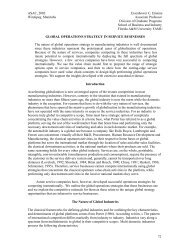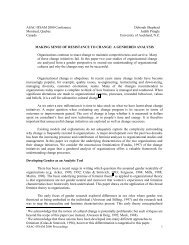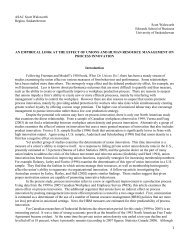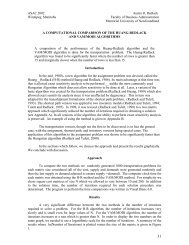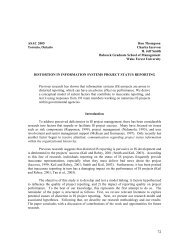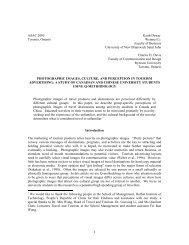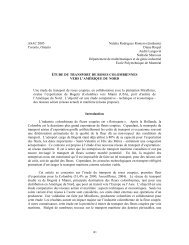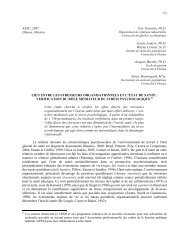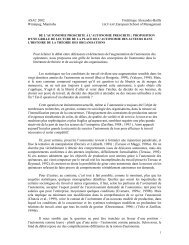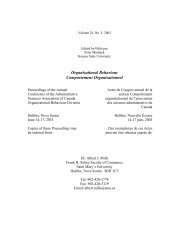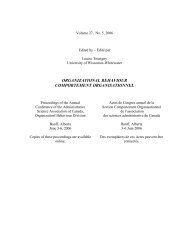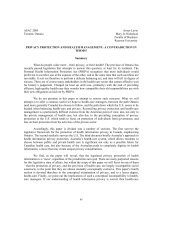ASAC 2002 Tania Spoljaric-Sherwood Winnipeg, Manitoba Stephen ...
ASAC 2002 Tania Spoljaric-Sherwood Winnipeg, Manitoba Stephen ...
ASAC 2002 Tania Spoljaric-Sherwood Winnipeg, Manitoba Stephen ...
- No tags were found...
Create successful ePaper yourself
Turn your PDF publications into a flip-book with our unique Google optimized e-Paper software.
<strong>ASAC</strong> <strong>2002</strong><br />
<strong>Winnipeg</strong>, <strong>Manitoba</strong><br />
<strong>Tania</strong> <strong>Spoljaric</strong>-<strong>Sherwood</strong><br />
<strong>Stephen</strong> Gismondi<br />
School of Hotel and Food Administration<br />
University of Guelph<br />
A PRELIMINARY EMPIRICAL STUDY OF ONTARIO TRAVEL TRENDS TO THE U.S. SOUTH<br />
ATLANTIC FROM 1990 TO 1998 AND CANADIAN/U.S. EXCHANGE RATES<br />
This empirical study provides useful information for both Canadian and<br />
American Travel and Tourism Industries and illustrates to what extent currency<br />
exchange rates may have influenced Canadian travel trends to the U.S. South<br />
Atlantic region. These results provide evidence to suggest that U.S. tourism<br />
stakeholders should develop and implement incentive programs for Canadian<br />
tourism to the U.S. or that they re-examine current Canadian target market<br />
strategies altogether, given existing Ontario / U.S. South Atlantic travel trends.<br />
Introduction<br />
The South Atlantic region of the U.S. includes the states of Virginia, North and South<br />
Carolina, Georgia, and Florida. This region has traditionally been an attractive and popular<br />
destination for Ontario vacationers due to its warm weather, sandy beaches, and exciting<br />
nightlife. Accustomed to long and cold winters in addition to variable short summers, many<br />
Canadians have traditionally chosen to plan their vacations south of the border in this region. The<br />
Canadian/U.S. exchange rate (exchange rate) has continued however, to broaden since September<br />
1990, when the exchange rate was 1.15 (Bank of Canada, 2001). The result of this has had<br />
obvious implications for Ontario travellers vacationing to the U.S. South Atlantic region who<br />
eight years later in September 1998, had to face an exchange rate of 1.52 (Bank of Canada, 2001).<br />
Through the use of the Statistics Canada International Travel Survey dataset, this paper<br />
develops indicators and provides evidence to confirm existing studies that a weakening Canadian<br />
dollar has negatively impacted total person visits made by Ontario travellers to the U.S. South<br />
Atlantic region from 1990 to 1998. These results support McCool’s work (1994) that suggests<br />
increased exchange rate has resulted in decreased total spending by Ontario travellers. Regression<br />
analysis follows resulting in two models that determine the outflow of Canadian currency from<br />
Ontario for use in tourist expenditures in the U.S. South Atlantic region and the inflow of U.S.<br />
currency to businesses in the U.S. South Atlantic region expended by Ontario tourists as a<br />
function of exchange rate. In summary, this study addresses the following issues:<br />
$ Definition of peak travel period indicators including determination of frequency of<br />
Ontario travel to the South Atlantic region of the U.S. from 1990 to 1998 for the peak<br />
travel months of January, February, March, April, and May<br />
$ Existence of a linear relationship between exchange rates and travel indicators<br />
$ Comments on the impact of Ontario tourist accounts to the U.S. South Atlantic as a<br />
function of exchange rate.<br />
$ Comments on the need for U.S. South Atlantic businesses reliant on Canadian tourism<br />
accounts to develop travel incentive packages to create additional value for customers or<br />
to formulate new target market strategies away from the traditional Canadian focus.<br />
In the 1980s and early 1990s, the United States was a popular and viable tourist<br />
destination for its Canadian neighbours. A decrease in Canadian tourism to the United States<br />
however, began to occur in the early 1990s and continues to persist present day. The articles<br />
discussed below support a common view that a decline in Canadian tourism to the United States<br />
has indeed occurred over the past decade primarily due to the weakening value of the Canadian<br />
67
dollar compared with that of the American dollar. Evidence exists to support the idea that<br />
exchange rate is a key factor in decisions that Canadians make when planning vacations to the<br />
United States. For the sake of brevity, only a small set of articles are discussed. But it’s<br />
important to point out that there exists an abundance of information in this area.<br />
Chadee and Mieczkowski (1987) discussed how the Canadian tourism industry<br />
experienced slow growth when the Canadian dollar depreciated in value by approximately 35%<br />
between 1976 and 1985. In their study, Chadee and Mieczkowski stated the main determinants of<br />
tourism demand as price, income, availability of substitute goods, and exchange rate. In addition,<br />
they further suggested that the depreciation of the exchange rate has had positive influences on<br />
the Canadian tourism industry.<br />
Di Matteo and Di Matteo (1993) also studied Canadian travel expenditures to the United<br />
States on a quarterly basis over the years 1979 through 1989. They suggested that both real per<br />
capita same day trips and one or more night trip expenditures were positively and significantly<br />
related to the real exchange rate expressed as Canadian dollars per U.S. dollar. In their regression<br />
analysis study, Di Matteo and Di Matteo suggested that one or more night automobile trip<br />
expenditures were positively and significantly related to exchange rate based expenditures. In<br />
addition, they suggested that same day automobile trip expenditures that could be taken as a<br />
proxy for cross-border shopping exhibited a real exchange rate elasticity of –2.31%.<br />
The question of what emphasis hospitality business owners and operators should place on<br />
fluctuating exchange rates may appropriately be considered at this point. According to Wilson<br />
(1992), foreign currency exchange rate fluctuations could result in adverse changes upon balance<br />
sheets, reported profit and loss, cash flows, and the cost of new asset purchases, unless managed<br />
properly. Wilson further indicated that to maximize revenue, hotels might have to re-consider<br />
yield management systems, computer systems, and sales incentive programs.<br />
In the late 1980s and early 1990s, several articles written during and after 1994, further<br />
suggested that a decrease in Canadian tourism to the United States was the result of a weakening<br />
Canadian dollar. According to the monthly average exchange rates provided by the Bank of<br />
Canada (2001), the exchange rate increased to $1.318 in January 1994 up from $1.277 in January<br />
1993, $1.156 in January 1992, and $1.156 in January 1991. These articles are: The Globe and<br />
Mail (1994), McCool (1994), Crouch (1994), and Webber (2001).<br />
Data and Methodology<br />
Secondary data has been acquired from the Statistics Canada micro dataset entitled<br />
“International Travel Survey- Canadian Resident Trips Abroad”. The dataset contains<br />
information on the travel habits of Canadian residents travelling abroad. The original dataset<br />
includes the results of 1,350,000 surveys conducted from 1990 to 1998 at Canadian/U.S. border<br />
crossings, a randomized sample from a population estimated to be at least 100 times larger (Tri<br />
University Data Resource, 2001). A subset of 3885 surveys were studied, according to the<br />
constraints outlined in the following paragraph. All computations are performed using Statistical<br />
Packages for the Social Sciences for Windows, V10.05. Daily exchange rates for the years 1990<br />
through 1998 have been acquired from the Bank of Canada exchange rate database accessed<br />
through the Tri University Data Resource Centre (2001).<br />
A subset of data has been selected regarding Ontario travellers to the U.S. South Atlantic<br />
region including the states of Virginia, North and South Carolina, Georgia, and Florida which has<br />
been refined to account only for those individuals travelling to the U.S. South Atlantic region for<br />
vacation purposes and residing in hotels and/or other paid accommodations. Following a<br />
frequency analysis, the data was further refined to include only the five most frequently travelled<br />
months in the year, according to the results illustrated in Table 1. These months were determined<br />
to be January, February, March, April, and May. Note that individuals traveling from Ontario to<br />
68
the U.S. South Atlantic region for business-related or other non-vacation purposes have been<br />
eliminated from the sample. The actual number of visits per person are not studied.<br />
The data is analyzed in three distinct parts referred to as parts I, II, and III.<br />
$ Part I is a frequency analysis based upon person-nights, across the entire sample, used to<br />
help determine what time of year is most active for Ontario tourists, although any number<br />
of measures, like total monthly spending, are just as useful.<br />
$ Part II examines a set of four indicators 1) total spending, 2) total per person spending, 3)<br />
total person nights and 4) total per person nights. These variables are defined below.<br />
$ Part III investigates two models:<br />
Model 1: y = mc + b + e, where y = total spending represented in Canadian<br />
currency (per annum) and c = exchange rate (mean per annum). This model<br />
attempts to measure Canadian currency leaving Ontario for use in tourist<br />
expenditures in the U.S. South Atlantic region, as a function of exchange rate.<br />
Model 2: y = mc + b + e, where y = total spending divided by exchange rate<br />
represented in U.S. currency (per annum) and c = exchange rate (mean per<br />
annum). This model attempts to measure the Canadian tourist impact in terms of<br />
revenue generated by businesses in the U.S. South Atlantic region, as a function<br />
of exchange rate.<br />
The following variables are defined in this study.<br />
$ Total spending: Total amount of money declared as ‘spent’ - often categorized on a per<br />
annum basis. Canadian dollars.<br />
$ Total per person spending: The mean value of money declared as ‘spent’ per person -<br />
often categorized on a per annum basis. Canadian dollars.<br />
$ Total person nights: Total number of nights declared as visiting the U.S. - often<br />
categorized on a per annum basis.<br />
$ Total per person nights: The mean value of nights declared as visiting the U.S. per person<br />
- often categorized on a per annum basis.<br />
$ Exchange: Exchange rates for the years 1990-1998 (Bank of Canada, 2001) Example:<br />
1.40 means $1.40 Canadian = $1.00 U.S.<br />
$ Canada (= Total Spending): Represents Canadian currency that will leave Ontario for use<br />
in tourist expenditures (total spending) in the U.S. South Atlantic region - often<br />
categorized on a per annum basis.<br />
$ States: Represents the buying power of Ontario tourist expenditures (total spending<br />
divided by exchange rate) in the U.S. South Atlantic region - often categorized on a per<br />
annum basis.<br />
Results<br />
The five most frequent months for Ontario travel to the U.S. South Atlantic region are<br />
January, February, March, April, and May, as inferred by Table 1 below. There are a variety of<br />
reasons for making this particular choice and a future study is planned to investigate November -<br />
May, a seven month period.<br />
Recall that absolute counts regarding person nights, and all financial figures that follow<br />
are based upon a restricted sample as outlined in the Data and Methodology section, five months<br />
of each year and are estimated to be less than 1/100 th of the actual number of Ontario tourists<br />
during the period 1990 through 1998. These figures are not indexed to inflation, although this is<br />
planned in future studies. A set of indicators are now investigated, presented as graphs.<br />
69
Table 1<br />
Part I - Percentage of Person Nights in the U.S. South Atlantic Region<br />
Month Percent Month Percent Month Percent Month Percent<br />
January 10.8 April 14.3 July 2.6 October 5.1<br />
February 13.3 May 8.4 August 5.5 November 7.3<br />
March 18.7 June 3.2 September 4.4 December 6.4<br />
Figure 1<br />
Part II - Total Spending (Canadian Currency) by Year<br />
Figure 2<br />
Part II -<br />
Per Person<br />
Spending<br />
(Canadian<br />
Currency)<br />
Year<br />
Total<br />
by<br />
70
Figure 3<br />
Part II - Total Person Nights by Year<br />
Figure 4<br />
Part II - Total Per Person Nights by Year<br />
71
A summary of the data prepared for linear regression is shown below in Table 2 and is<br />
graphically illustrated in Figures 5 & 6 below. Recall that variable ‘Canada’ represents Canadian<br />
currency that leaves Ontario for use in tourist expenditures (total spending) in the U.S. South<br />
Atlantic region. Variable Canada was regressed against exchange rate independent of year, called<br />
model 1. Recall that the variable ‘states’ represents the buying power of Ontario tourist<br />
expenditures (total spending divided by exchange) in the U.S. South Atlantic region. Total<br />
spending divided by exchange (States) was regressed against exchange rate independent of year,<br />
called model 2.<br />
Table 2<br />
Part III - Ontario Tourist Expenditures<br />
Year Exchange Canada ($1,000s) States($1,000s)<br />
1990 1.18 1264.00 1071.86<br />
1991 1.15 1005.00 873.91<br />
1992 1.18 715.00 605.93<br />
1993 1.26 737.00 584.92<br />
1994 1.35 215.00 159.26<br />
1995 1.41 243.00 172.34<br />
1996 1.37 391.00 285.40<br />
1997 1.37 533.00 389.05<br />
1998 1.43 319.00 223.08<br />
Figures 5 & 6<br />
Part III - Outflow/Inflow from/to Ontario to/from<br />
U.S. South Atlantic Region (Canadian/U.S. Currency)<br />
Figure 5 Figure 6<br />
While the data points from Table 2 are joined together in Figures 5 and 6, this merely<br />
suggests linear interpolation. The results of the regression analysis are shown below.<br />
Model 1 is significant, p = 0.002, r 2 = 0.88, given by: total spending (per annum) = -<br />
2949.4c + 4435.7. (Canada versus Exchange). Model 2 is significant, p = 0.001, r 2 = 0.90, given<br />
by: total spending (per annum) = -2716.7c + 4015.9. (States versus Exchange)<br />
72
Note that regression coefficients for these models are computed based upon aggregated<br />
per annum exchange rates rather than daily rates.<br />
Discussion<br />
Figure 1 suggests that total spending by Ontario tourists in the U.S. South Atlantic<br />
decreased during the years 1990 through 1994, improved slightly from 1995 through 1997, and<br />
dropped in 1998. These results may indicate that Ontario travellers spent less money per year in<br />
the U.S. South Atlantic region from 1990 through 1994, during which time the difference in the<br />
exchange rate began to increase. This result supports the study of Canadian travel expenditures to<br />
the U.S. by DiMatteo and DiMatteo (1993), who suggest that same day trips and one or more<br />
night automobile trip expenditures are positively and significantly related to exchange rate based<br />
expenditures. Moreover, while Ontario travellers to the U.S. South Atlantic region spent more<br />
each year from 1995 through 1998, total spending was less than it had been in the early 1990s.<br />
Figure 2 suggests that the total per person spending of Ontario travellers increased in the<br />
U.S. South Atlantic region during the years 1990 through 1998. This may imply that while the<br />
sum of all spending by Ontario tourists has decreased in this region (Figure 1), those who are<br />
coming to the area are spending more per annum. These results are consistent with another idea -<br />
that individuals who are travelling to the U.S. South Atlantic region may be part of an affluent<br />
demographic segment and as a result can afford to travel to the region despite large fluctuations in<br />
the exchange rate. This brings into account the question of whether a vacation to the U.S. South<br />
Atlantic region is an affordable trip to other Ontario demographic segments such as middle-class<br />
salary earners when the exchange rate is minimal and if the same vacation package becomes a<br />
luxury good when the exchange rate increases.<br />
Figure 3 suggests that the total person nights of Ontario travellers in the U.S. South<br />
Atlantic region decreased during the years 1990 through 1998. Notice the similar trend in the<br />
results of this graph and those of total spending illustrated in Figure 1. Similarly, between the<br />
years 1990 through 1994, total person nights spent in the region decreased, followed by a slight<br />
increase between 1995 and 1997, and a drop again in 1998. These results may suggest that as the<br />
comparative value of the Canadian/U.S. dollar broadened from 1990 through 1994, Ontario<br />
travellers spent fewer overnight stays in the U.S. South Atlantic region, consistent with the above<br />
noted trend. Although total person nights increased from 1995 through 1997, they were<br />
considerably fewer than the region had experienced in the early 1990s.<br />
In Figure 4, the total per person nights of Ontario travellers appears to decrease in the<br />
U.S. South Atlantic region during the years 1991 through 1995. Total per person nights however,<br />
appears to increase in 1996, more dramatically than a trend might seem to indicate in other graphs<br />
depicting total spending, total per person spending, and total person nights. Overall it does not<br />
appear that exchange rate has had a large effect on the length of time that Ontario travellers<br />
stayed in the U.S. South Atlantic region, about three weeks. It appears as though Ontario<br />
travellers to the U.S. South Atlantic region have continued to plan the same length of vacation,<br />
despite the finding that fewer Ontario travellers are vacationing in the region.<br />
Recall regression models Model 1 and Model 2. While these results are over-simplified,<br />
and do not account for the variety of reasons that Canadians might vacation in the U.S. South<br />
Atlantic region, these ideas should be further studied given such high degree of model fit. These<br />
models may also be useful to help predict demand, assuming they are further developed. For<br />
example, the U.S. South Atlantic region has traditionally been a popular vacation destination for<br />
Canadians who have desired a warm climate with ocean and beaches in a familiar neighbouring<br />
country. For this reason, targeting Canadian vacationers has traditionally been a viable strategy<br />
for many U.S. businesses. These models may help provide insight to U.S. businesses that depend<br />
upon Canadian tourists for generating a percentage of revenues because they illustrate a<br />
capability to determine the inflow of U.S. currency to their businesses given a certain exchange<br />
73
ate. While these businesses are limited by knowledge of future exchange rates, they can<br />
however study past and present trends in the economy and associated exchange rates to estimate<br />
future exchange rates for use in forecasting measures or at least use the model to gain an<br />
appreciation of Canadian sensitivity to exchange rates.<br />
The following discussion now focuses on the need for U.S. South Atlantic region<br />
businesses, which have traditionally targeted Canadian vacationers, to develop value-added travel<br />
incentive packages to compensate for perceived lost value if exchange rate continues to increase.<br />
In light of the unpredictability that exists with respect to exchange rate fluctuations, the need may<br />
exist for some businesses to re-examine their target market strategies and consider other<br />
international market groups who do not experience similar events with respect to exchange rates.<br />
The increasing difference between the value of the Canadian and U.S. dollar has affected<br />
Ontario travel accounts to the U.S. South Atlantic region since the early 1990s. In light of these<br />
findings, one must consider the cost/benefit implications for U.S. businesses to continue their<br />
traditional (and once successful) market objectives in acquiring and maintaining Ontario tourist<br />
accounts. In the late 1980s and early 1990s, many U.S. businesses were able to accept Canadian<br />
money at par (Flanagan, 1995). The difference between Canadian and U.S. currencies was small<br />
and accordingly, U.S. businesses could absorb the incurred difference or increase the price of the<br />
good to U.S. residents, resulting in both countries paying more for the product or service. With a<br />
growing difference however, in the value of the two currencies since the early 1990s, ability to<br />
offer U.S. goods and services at par has become an increasingly difficult feat for U.S. businesses.<br />
Incentive package deals consisting of complete travel packages including transportation,<br />
accommodation, activities, etc., as proposed by Flanagan (1995), attempt to provide Canadian<br />
travellers with value-added incentives for travel. But the success of this approach depends upon<br />
the perceived value of bundled products and actual costs of these products - an entire study of its<br />
own. Exchange rate alone raises the question of value as perceived by the tourist. In the mind of<br />
the Canadian traveller or any individual from a country who possesses a weaker currency than<br />
that of the travel destination country, the value associated with pursuing a travel experience can<br />
be related to the extra money paid in currency exchange to acquire a particular experience. In this<br />
scenario, in order to capture Ontario travellers, they need to be convinced that they will aquire<br />
greater value in the vacation experience to the U.S. than by travelling in Canada or elsewhere<br />
where the currency exchange is minimal. Although most individuals may not analyze a travel<br />
destination decision like the above example illustrates, this study might be viewed as evidence<br />
that Ontario tourists indeed share this viewpoint and are no longer convinced that a U.S. South<br />
Atlantic vacation offers sufficient value - sun and sandy beaches aside.<br />
74
References<br />
Bank of Canada., Bank of Canada: Monthly Average Exchange Rates. 2001.<br />
Available: http://www.bank-banque-canada.ca<br />
Canadian Press Newswire, “Americans Flock to Canada in July”, Sept. 16, 1998.<br />
Chadee, D., & Mieczkowski, Z., “An Empirical Analysis of the Effects of the Exchange Rate on<br />
Canadian Tourism” Journal of Travel Research, 26(1), 1987.<br />
Crouch, G., “Demand Elasticities for Short-Haul versus Long-Haul Tourism” Journal of Travel<br />
Research, 33(2), 1994.<br />
Di Matteo, R., & DiMatteo, L., “The Determinants of Expenditures by Canadian Visitors to the<br />
United States” Journal of Travel Research, 31(4), 1993.<br />
Flanagan, W., “Streeeetching It” Forbes 155(10), 1995.<br />
Globe & Mail Metro Edition, “Sun Seekers Flee Canada” Toronto, Ontario, 1992, B1, B3.<br />
McCool, S., “Issues in Tourism” Montana Business Quarterly, 32(1), 1994.<br />
Strizzi, N., & Bailie, G., “The Evolution of Canada’s Travel Account” Journal of Travel<br />
Research, 39(03), 2001.<br />
Tri University Data Resource, International Travel Survey: Canadians to U.S. 1990-1999, 2001.<br />
Available: http://tdr.uoguelph.ca<br />
Webber, A., “Exchange Rate Volatility and Co integration in Tourism Demand” Journal of<br />
Travel Research, 39(4), 2001.<br />
Wilson, R. (1992). “International Acquisitions and Foreign Currency Exchange Risk<br />
Management” Journal of Hospitality Financial Management, 2(1), 1992.<br />
75



